In recent years, rural innovation has become more popular. It shows the potential of business ideas in less urban areas. These ideas are not just a fix for regional problems. They are a way to grow sustainable businesses and improve rural areas.
By using local culture and natural resources, rural areas can grow economically. This growth is often overlooked by city-focused plans. The Australian Bureau of Statistics (ABS) says rural areas can help the national economy grow. They create a space for entrepreneurs to thrive.
Understanding the Landscape of Rural Innovation
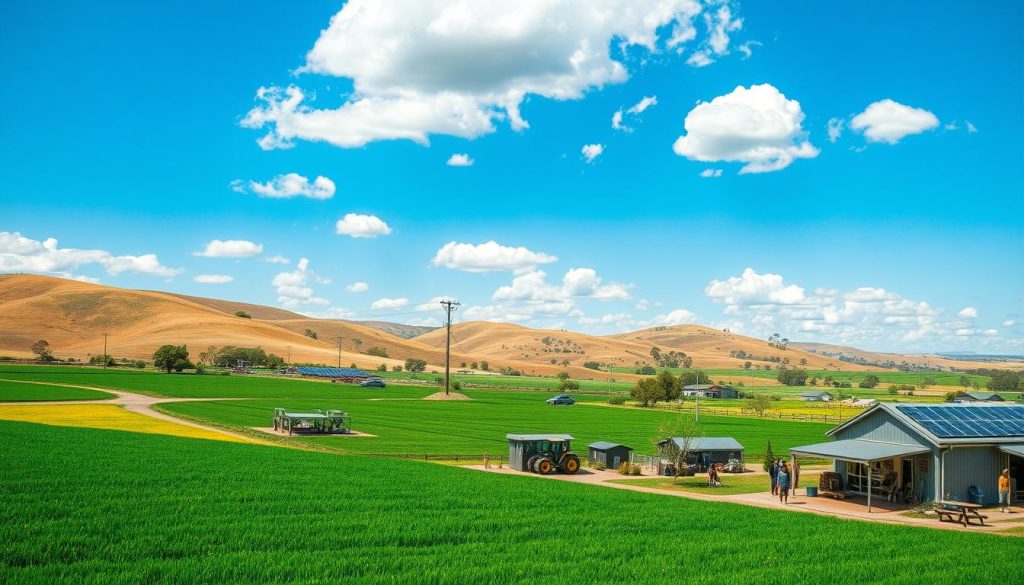
The rural business scene in Australia is full of unique chances and hurdles. It’s different from city life. Here, communities are tight-knit, using local resources and old ways. They mix technology with farming and local business.
Demographic changes, like fewer people in some places, and a push for green practices, shape these innovations. Rural entrepreneurs face big challenges, like finding money, lacking skills, and being cut off from markets. The Regional Australia Institute says it’s vital to understand these issues to create effective plans for rural areas.
Also, linking community needs, local resources, and market chances helps rural innovations thrive. Good ideas come from combining local business spirit with new trends. These ideas should match the Australian countryside’s economy and what people want.
Impact of Technology on Rural Businesses
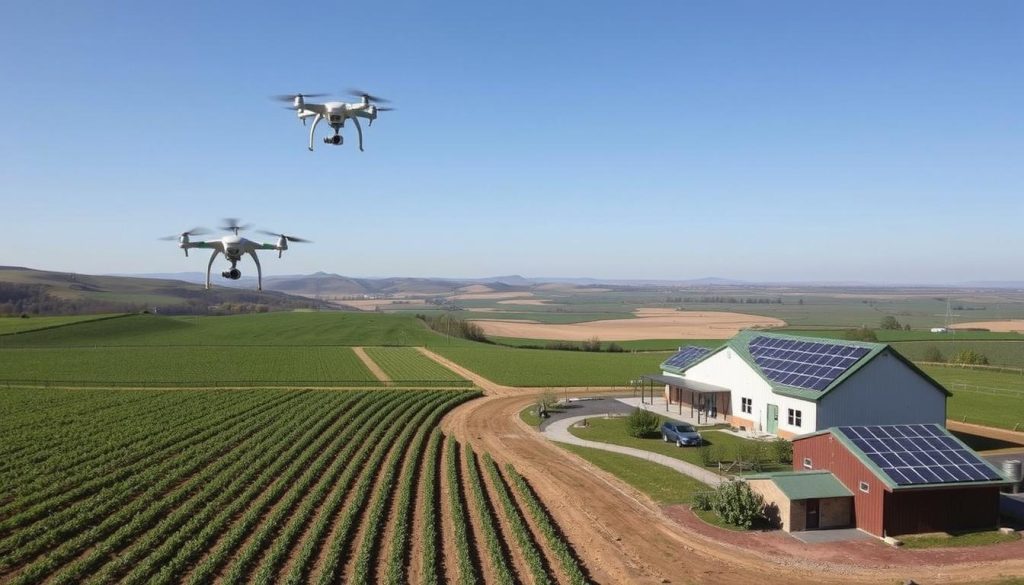
Technology is changing how rural businesses work and reach customers. It’s making them more efficient and accessible. With digital tools, rural businesses can do better and connect with more people.
Mobile apps and online stores are key for staying ahead. They help rural businesses compete in today’s fast-paced market.
Studies show how tech is helping rural areas. Farmers use new tech to grow more crops with less effort. This not only increases their yield but also helps the environment.
Local craftspeople are also benefiting. They sell their work online, reaching more people. This shows how technology can help small businesses grow.
New tech like cloud computing and data analysis offers more chances for rural businesses. They help make decisions easier and operations smoother. CSIRO research shows that using these technologies can lead to more productivity.
Innovative Business Ideas for Rural Areas in Australia

Rural areas in Australia are becoming hubs for new business ideas. These ideas reflect the special qualities of their environments. They help make these areas more economically stable.
Agri-Tech Solutions
The Agri-Tech sector is changing farming with advanced technology. It lets farmers check on crops in real-time and use resources better. This way, they can grow more while harming the environment less.
As Australia is a leader in Agri-Tech, rural businesses can use these technologies. They can start sustainable farming practices that help the land and local people.
Remote Work Opportunities
Remote work trends have opened up new chances for people in rural areas. With fast internet, they can work for global companies. This boosts their earnings and helps the local economy grow.
Creating co-working spaces in towns can attract more entrepreneurs. It brings in different talents and helps the area thrive.
Eco-Tourism Ventures
Eco-tourism in Australia is growing, and rural areas can benefit. They can offer real experiences to visitors. This includes eco-friendly lodgings, nature tours, and cultural activities.
These ventures help local economies and encourage visitors to see rural Australia’s beauty. They also support environmental conservation.
Community-centric Business Models

Community-driven business models have changed rural entrepreneurship. They focus on teamwork, helping local businesses grow. This also makes people feel part of the community.
These models include collaborative spaces. These spaces give businesses the tools and connections they need. They help entrepreneurs stay motivated and grow.
Collaborative Workspaces
Collaborative spaces are key for local entrepreneurs. They provide a place for people to work together and share ideas. This is especially helpful in rural areas where resources are limited.
These spaces boost productivity and encourage innovation. Entrepreneurs get to share skills and feel part of a community. This helps them grow and succeed.
Local Art Initiatives
Local art initiatives are also crucial. They help businesses and keep cultural heritage alive. By supporting local artists, businesses can attract visitors and strengthen community identity.
Studies from the Australian Arts Council show the benefits. Investing in local art boosts the economy and unites communities. It’s a key part of rural entrepreneurship’s success.
Case Studies of Successful Rural Innovations
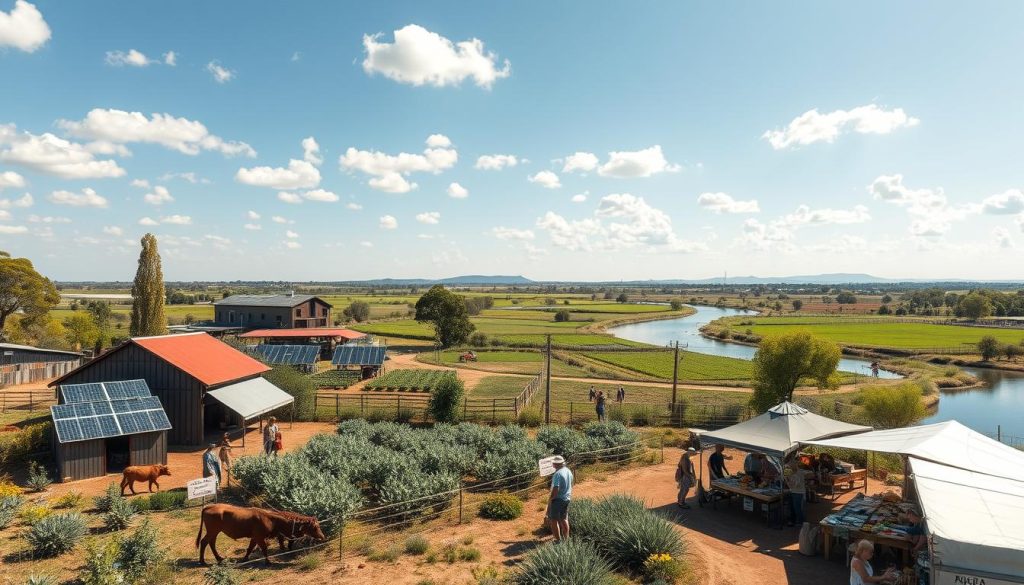
In Australia, rural areas have seen a surge in innovative ventures. These have greatly boosted local economies. For example, an agri-tech company has changed the way crops are managed. They use new technology to grow more and use less resources.
Another success story is a community-led eco-tourism project. It draws visitors worldwide. This not only showcases local culture but also creates jobs for locals. It shows how teamwork and community involvement are key to success.
Looking at different success stories, we see the value of good practices. These stories offer insights into what works well. The Rural Development Network’s data helps us learn from these successes.
The Role of Government Support in Rural Entrepreneurship

Government support is key for growing rural entrepreneurship in Australia. Many programs help entrepreneurs start or grow their businesses. These include grants and schemes for start-ups and new projects in rural areas.
The Australian Government has launched funds like the Rural Innovation Fund and the Regional Growth Fund. These funds help make rural businesses more viable. They show the government’s dedication to boosting local economies and supporting entrepreneurs.
Statistics from the Department of Industry show government funding helps rural businesses succeed. These programs give financial help and tools to tackle challenges. They empower entrepreneurs to grow their ventures.
- Rural business grants foster innovation and sustainability.
- Policy support ensures that entrepreneurs have access to vital resources.
- Government assistance can significantly reduce the risks associated with start-ups.
Environmental Sustainability in Rural Businesses
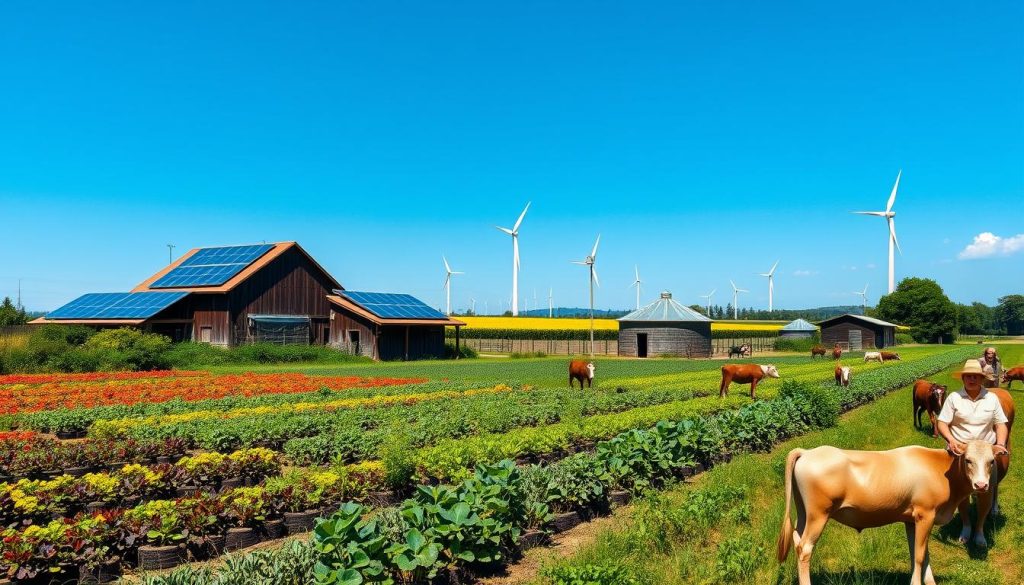
Environmental sustainability is key to rural business success. Using renewable energy and eco-friendly products boosts efficiency and meets consumer needs. It also builds a strong community by focusing on the planet.
Sustainable farming in rural areas is a big win. Techniques like crop rotation and organic farming improve soil health and cut chemical use. This approach helps entrepreneurs reduce their environmental impact and increase productivity.
The Australian Environmental Protection Agency shows sustainable methods are economically wise. They help businesses stay strong even when times are tough. With more people wanting to buy from eco-friendly companies, rural entrepreneurs have a chance to grow and stand out.
Leveraging Local Resources for Business Success
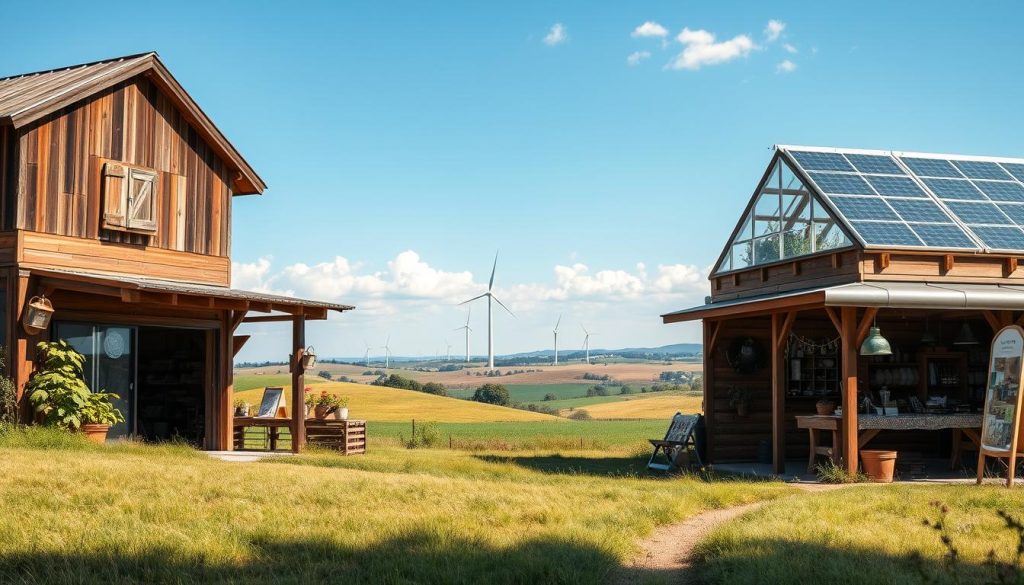
Using local resources is key for rural businesses to thrive. Focusing on natural materials and green practices boosts product appeal. It also gives businesses a competitive edge.
By choosing materials like timber from sustainable forests or organic produce from local farms, businesses can offer unique items. These items attract eco-aware customers.
Natural Materials and Sustainable Practices
Using natural materials in product design helps rural businesses succeed. It builds a bond with the community and shows a commitment to the environment. Businesses that focus on sustainability often see higher customer loyalty and better profits.
Statistics from the Bureau of Rural Sciences show these businesses outperform others. They do this by choosing ethical sources and caring for the environment.
Also, working with local suppliers strengthens the local economy. This support for local resources fosters a sense of community. It encourages people to buy from businesses that help the area.
In the end, combining local sourcing with green practices is crucial. It sets the stage for long-term success and profit in rural businesses.
Market Trends Influencing Rural Business Ideas
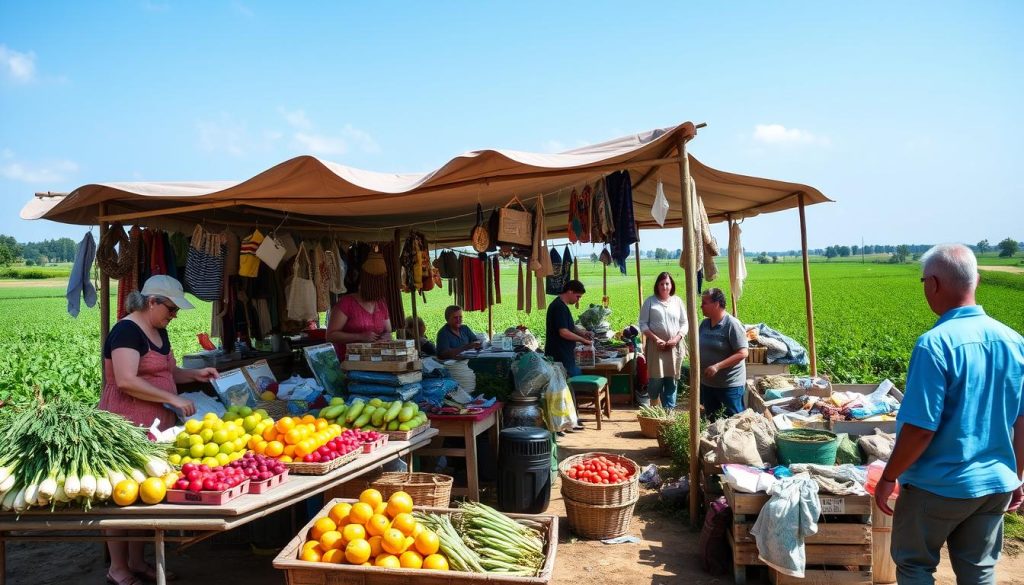
Today, there’s a big move towards wanting local products. This change is making rural business chances better and pushing entrepreneurs to keep up with what people want. People now prefer buying things that are real and good for the planet.
Local items are not just popular; they also make a place feel more special. They show off the area’s unique character.
Consumer Demand for Local Products
More and more people want to buy things made locally. They see the good in it, like:
- Helping local economies grow
- Being kinder to the environment
- Supporting local artists and farmers
This trend is great for rural businesses. It means they can focus on making high-quality, eco-friendly products. By doing this, they can do well and help their communities too.
The Importance of Networking in Rural Areas
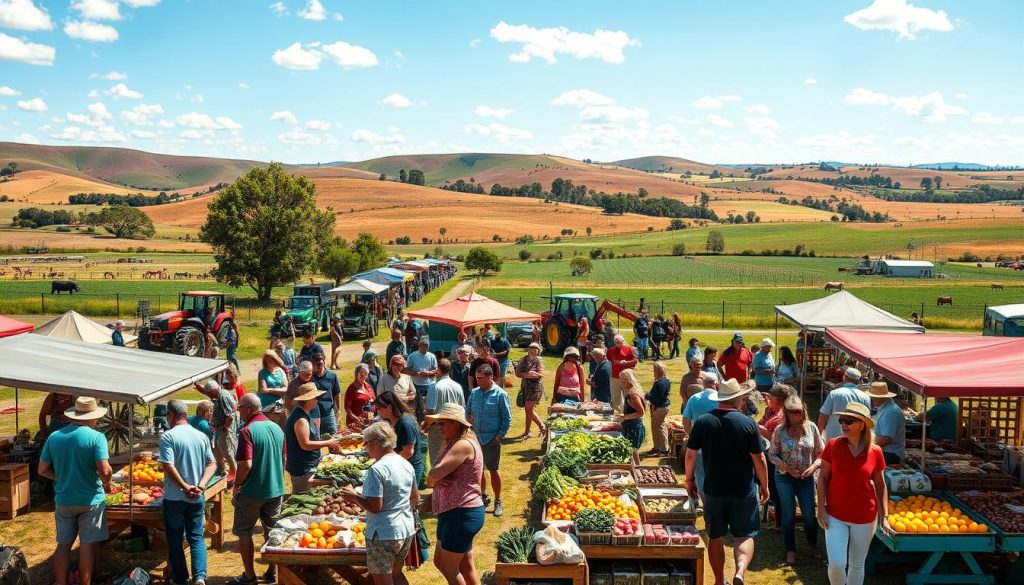
Networking is key for entrepreneurs in rural areas. It helps build strong ties between local businesses, community groups, and government. These connections offer vital support and resources, helping businesses grow in tough environments.
Local networks, like chambers of commerce, are great for getting noticed. Being part of these groups can lead to good business relationships. This sharing of resources helps rural businesses succeed and stay strong against economic ups and downs.
The Small Business and Family Enterprise Ombudsman stresses the value of community ties. They say strong networks can improve business results. Ways to build these relationships include:
- Going to local networking events
- Working together with nearby businesses
- Getting involved with community groups
- Using social media to connect
In short, networking is vital for growth in rural areas. It creates a space where businesses can work together and thrive.
Barriers to Innovation in Rural Locations

Rural innovation faces many challenges. One big issue is the lack of access to capital. Many entrepreneurs find it hard to get funding for their ideas. Banks often see rural areas as risky, which limits growth and creativity.
There’s also a shortage of skilled workers in rural areas. This makes it tough for local businesses to attract and keep talent. The remote location of rural areas makes networking even harder. This is key for sharing ideas and working together.
A report from the Australian Productivity Commission suggests improving infrastructure can help. It also recommends targeted support to overcome these challenges. To create a better environment for innovation, everyone needs to work together. This includes governments, businesses, and community groups.
Creating an Entrepreneurial Ecosystem
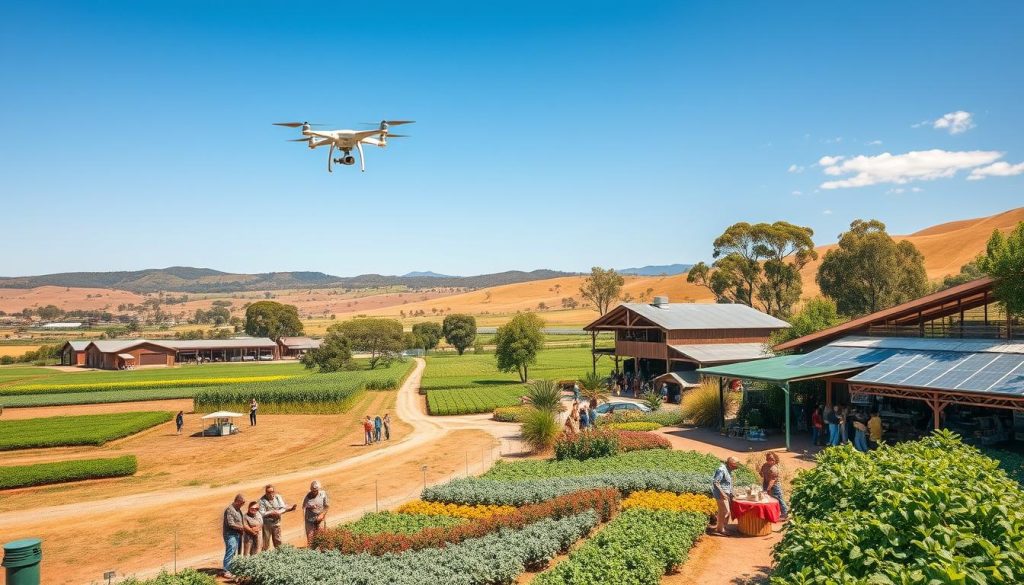
To make rural areas thrive, we need everyone to work together. This includes entrepreneurs, investors, and community leaders. Investing in these areas is key to helping new businesses grow. It also helps in making the environment better for start-ups in rural areas.
There are now different ways for investors to help. These options let them make a real difference in these communities.
Investment Opportunities in Rural Innovation
There are many chances to invest in rural innovation. Here are some main ones:
- Venture capital that supports rural start-ups with big plans.
- Public-private partnerships that bring together resources for innovation.
- Grants and subsidies from governments to boost local economies.
- Angel investors who work closely with entrepreneurs in rural areas.
The Australian Investment Authority shares stories of rural ventures that did well with the right investment. This shows how rural areas can grow and succeed. By building a strong entrepreneurial ecosystem, rural areas can use their talent and resources well. This ensures a bright future for businesses and communities.
Rural Innovations in Agriculture and Farming
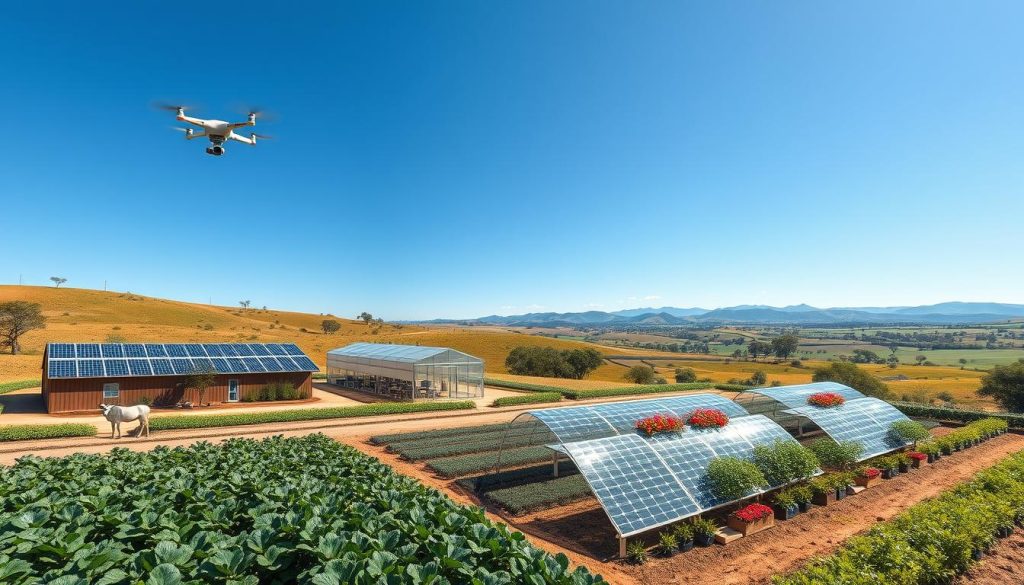
Recent years have seen big changes in farming. These changes make farming more efficient and better for the environment. They use the newest technology to help farms in rural areas grow more.
Smart farming technology is a big step forward. It uses sensors, drones, and data to help farmers grow more crops. Farmers can check soil health, use water wisely, and apply fertilisers just right. This cuts down waste and makes farming more sustainable.
Regenerative farming is also becoming more popular. It focuses on making soil healthy and keeping biodiversity strong. By using cover crops and no-till farming, farmers can lock in carbon, keep water, and grow more. This way, farming is good for the planet and for farmers.
Vertical farming is another exciting innovation. It grows crops in layers, even in cities. This method uses less land but grows more per square metre. Hydroponics and aeroponics in vertical farms make sure water and nutrients are used well, helping farming be more sustainable.
Education and Skill Development for Sustainable Ventures
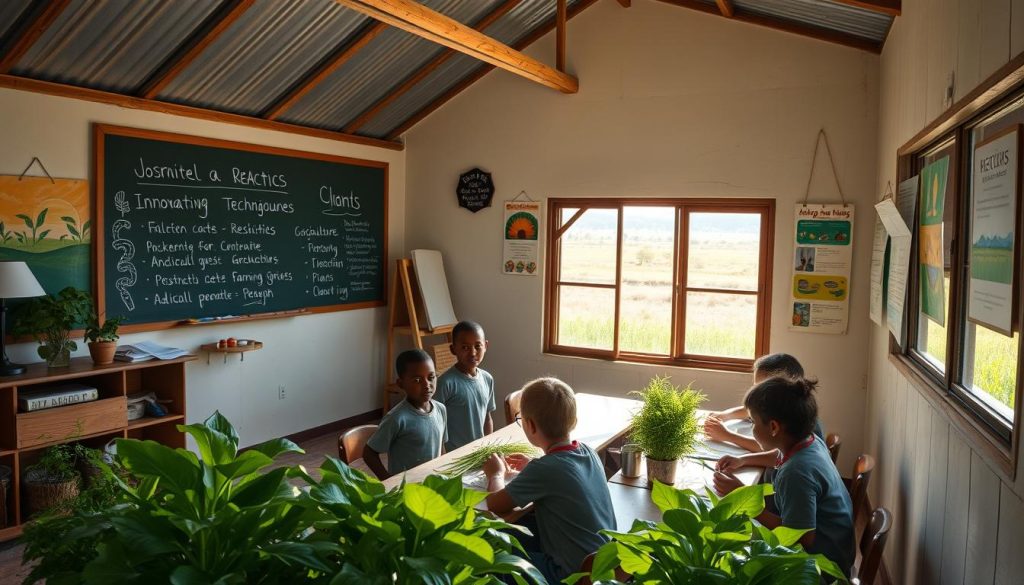
Education in rural areas is key to empowering entrepreneurs. It helps them develop sustainable business practices. Skill development programmes give people the knowledge and tools they need to succeed.
These programmes often include vocational training. This allows participants to learn skills specific to local industries. This way, they can contribute effectively to their communities.
Working with schools and universities is very helpful. It brings targeted vocational training to rural areas. This helps address skill gaps and boosts employability.
Workshops at community levels also play a big role. They encourage innovation and resourcefulness. This is crucial for entrepreneurship education.
Investing in education is essential. Studies show that a well-trained workforce can handle modern business challenges better. By focusing on education and skill development, rural areas can grow economically and sustainably.
Harnessing Social Media for Rural Marketing

Rural businesses face unique challenges in getting noticed. Yet, a good social media strategy can change their marketing game. By using Facebook, Instagram, and Twitter, they can reach more people than ever before.
Using social media for marketing lets local businesses connect with their community. They can share stories, show off their products, and promote events. This helps build strong relationships with customers.
Many examples show how digital marketing can boost rural businesses. For example, a farm shop used Instagram to share its produce and recipes. This not only drew in more people but also increased community involvement.
Studies show digital channels are becoming more important for engaging customers. Rural businesses using social media can overcome distance barriers. This way, they can share their products with more people and highlight the value of local goods.
Future Trends in Rural Australian Business Innovations
Looking ahead, rural Australian businesses are set for big changes. New business models will focus on being green and using technology. This shift is driven by people wanting eco-friendly products and clear supply chains.
Businesses that adopt these trends will meet customer needs and boost local economies. This is a chance for growth and success.
Technology is key in rural innovation. It includes smart farming and online marketplaces for local goods. These tools improve efficiency and connect communities.
Reports from the Australian Institute of Business and Innovation underline the need for businesses to be flexible. This flexibility is crucial as new technologies emerge.
Rural entrepreneurs must work with schools and use local skills. A team approach that values learning and networking is essential. This way, businesses can stay ahead and support a strong, green economy.
















